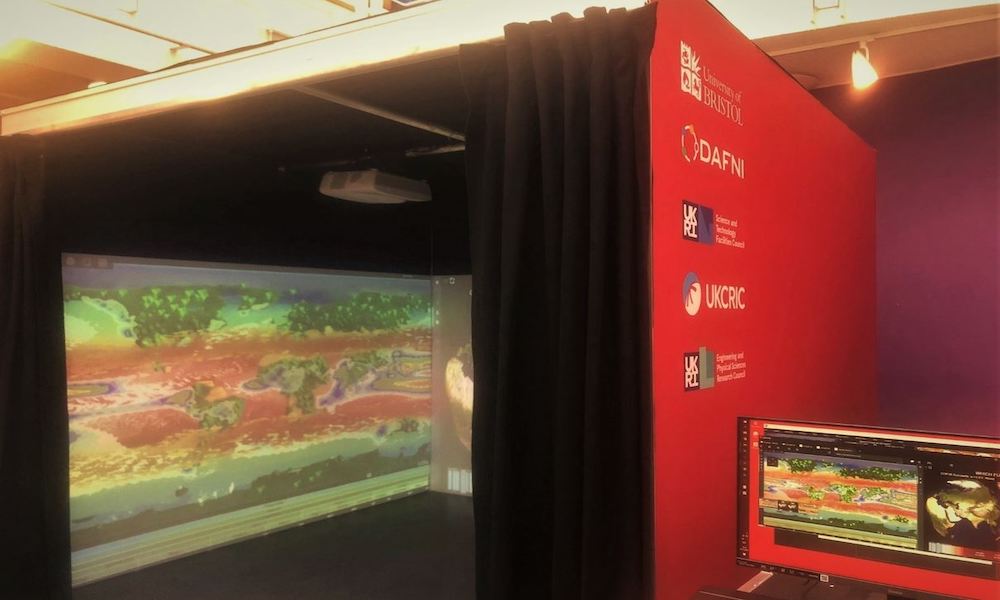
Case study:
The University of Bristol’s portable immersive data space for infrastructure data visualisation
By Dr Patrick Tully, project manager for UKCRIC activities at the University of Bristol
The use case
We applied to the DAFNI hardware fund with a use-case for equipment that we could use in our engagement work with schools around Bristol.
We wanted an immersive space where we could comfortably fit 6 people when we’re in an era with no COVID restrictions in place; with the current social distancing we are able to use it with 2 people at once.
Our first users of the system have been researchers within the university, across a number of different research groups, with more researchers exploring how they could use it in the future.
At the School of Psychology, researchers from the Urban Vision Science team are using the immersive data space to see how people react to a changed environment in order to better study how pedestrians move through space, as part of a UKCRIC Bristol Infrastructure Collaboratory and the University Strategic Research Fund Project “Urban Vision – Understanding the impact of visual environments on physical and mental wellbeing”. People may react instinctively to lines created by paving or steps, for example, and this can cause problems in urban environments, or indeed create better flow of people.
Within the EPSRC Centre for Doctoral Training in Cyber Security at University of Bristol, researchers including Trevor Jones have been trained on the immersive space. Trevor is using the space for his research into cyber security and TIP/S, in a project involving the use of urban digital twins and their visualisation to evaluate TIP/S issues around the implementation of new smart city technologies.
Trevor explains, “Access to the [DAFNI] immersive space will be a real boon to my project and research for a few reasons: it allows me to explore differences in how visualisation affects usability and use, as well as providing me with a gorgeous platform to attract potential research users when it comes time to conduct the sociological, human-focused, portion of my research. I can imagine the immersive space will be incredibly engaging at a real event – which brings not only the benefit of exposure for the University and our partners, but the possibility to engage with more subjects for user studies.
“Even though we’ve only just learned how to set it up, I can’t wait to see the creative, interdisciplinary ways projects integrate this device into their research. I’d like to thank DAFNI, the TIP/S CDT, UKRIC, the other organisations, and more importantly all the people who came together to make this opportunity possible.”
Find out more in Trevor’s blog.
Researchers at the Jean Goulding Institute for Data Science have been using the immersive space to visualise their data and provide the backdrop for video interviews about their work.
What does the DAFNI equipment allow you to do?
A key part of our work is to generate lots of data about urban environments and the data is often difficult to display in a meaningful way without it being overwhelming.
We are using the novel environment of the immersive space to drive engagement and encourage people to interact with the space in a more physical and interactive way than we might otherwise have done using PowerPoints projected on the wall, for example.
How do you plan using it in the future?
Once COVID restrictions have been lifted we will be using the immersive space as part of our engagement programme with schools, in particular around air quality. Within the Urban Observatory resources, we have a number of air quality monitors installed throughout the city and we can also use sensors at school sites.
Our engagement programme will include work with local primary schools and secondary schools in the city, for example to empower the students and staff to have some influence over the environment in their locality and to allow them to engage with external partners to discuss how the air quality impacts on them. Ultimately the engagement programme with schools will be a positive driver for change in air quality by allowing people to better visualise and understand the data.
We will also be working with local authorities. We will be using the data from the UKCRIC Urban Observatory at University of Bristol and other Urban Observatories to support better decision-making about urban analytics. For example, we will be able to present the data in an engaging way to Bristol City Council to help them use the data to have a positive impact on society. We will be able to analyse data on water quality from our sensors in the floating harbour, from our air quality sensors and from our sensors at Clifton suspension bridge from which we can analyse traffic moving across the city.
We are also considering wider projects with sustainability groups where use-cases arise.
Currently our sensors vary in terms of how often they grab the data, some of them are in real-time, some capture data every five minutes, and the data is generally uploaded in batch to our servers. Our aspiration is to have real-time data showing in the immersive space – after we’ve combined datasets and carried out data analysis and visualisation on DAFNI platform.
The interaction with the space will vary hugely depending on how people engage with it.
There are many options and different ways of getting data projected into the space, such as three separate PowerPoints on each wall or through gaming engines like Unity which project 3D worlds or 360 videos allowing people to interrogate the scene, to recreate cities, find where a sensor is and display data, or to show a changing, moving cloud of something to show poor air quality. We can also take information from GIS data or AutoCAD models and put those into the projections. It’s a very flexible set up and we’re still very much exploring the possibilities.
How does the university plan to link the hardware use with the DAFNI platform?
The unique value of the DAFNI platform lies in the ability that it gives researchers to combine existing datasets regarding infrastructure — and there’s a lot of interest in that across the UK and further afield.
We will also be able to analyse and visualise data on DAFNI to use with the immersive space.
We’re actively encouraging people to engage with our new equipment as well – we’d welcome approaches from other researchers within the university as well as external groups who’re interested in helping us to develop different ways of using it.
We need people to push the boundaries of our immersive space and the DAFNI platform to fully understand where the power of them is.
The hardware
Dr Theo Tryfonas, Professor of Infrastructure Systems and Urban Innovation, Department of Civil Engineering, leads the project at Bristol and we discussed engagement works with schools internally and then went out to the market to see what was available in terms of portable immersive data spaces.
We were initially considering a dome that would have been easier to transport but did not offer the quality that we were looking for. When we applied to the DAFNI fund we gave brief examples of the type of equipment that we were looking for and when we were awarded the funding we went to market to see what was available and what would suit our needs. We wrote a detailed tender which was put out through the university system.
The system we chose meets our expectations around portability – we can put it up in around 3 hours, take it down in around 2 hours; so we can take it out to a school for a day visit in our transit van and use it without having to erect it the day before or take it down the day after.
The facility features 270-degree screens inside a 3-metre square enclosed space, equipped with high-definition projectors and 5.1 surround sound. A high-powered computer allows for detailed data visualisation and 3D models to be warped seamlessly around all sides of the space. A 5.1 immersive surround sound system and 3, 4000- lumen HD projectors with ultra-short throw projection technology, to minimize shadowing and maximize the usable space of the system.
